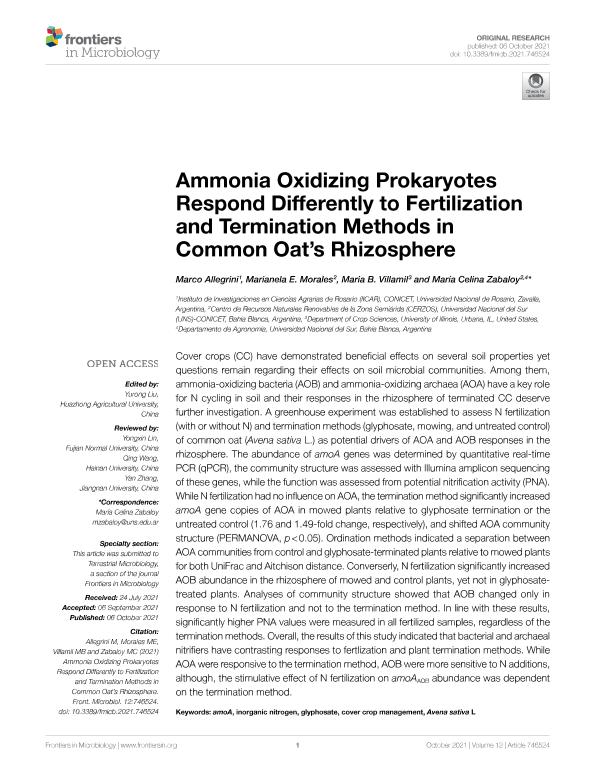Mostrar el registro sencillo del ítem
dc.contributor.author
Allegrini, Marco

dc.contributor.author
Morales, Marianela Estefania

dc.contributor.author
Villamil, Maria Bonita

dc.contributor.author
Zabaloy, Maria Celina

dc.date.available
2022-06-14T10:52:16Z
dc.date.issued
2021-10-06
dc.identifier.citation
Allegrini, Marco; Morales, Marianela Estefania; Villamil, Maria Bonita; Zabaloy, Maria Celina; Ammonia Oxidizing Prokaryotes Respond Differently to Fertilization and Termination Methods in Common Oat’s Rhizosphere; Frontiers Media; Frontiers in Microbiology; 12; 6-10-2021; 1-15
dc.identifier.issn
1664-302X
dc.identifier.uri
http://hdl.handle.net/11336/159653
dc.description.abstract
Cover crops (CC) have demonstrated beneficial effects on several soil properties yet questions remain regarding their effects on soil microbial communities. Among them, ammonia-oxidizing bacteria (AOB) and ammonia-oxidizing archaea (AOA) have a key role for N cycling in soil and their responses in the rhizosphere of terminated CC deserve further investigation. A greenhouse experiment was established to assess N fertilization (with or without N) and termination methods (glyphosate, mowing, and untreated control) of common oat (Avena sativa L.) as potential drivers of AOA and AOB responses in the rhizosphere. The abundance of amoA genes was determined by quantitative real-time PCR (qPCR), the community structure was assessed with Illumina amplicon sequencing of these genes, while the function was assessed from potential nitrification activity (PNA). While N fertilization had no influence on AOA, the termination method significantly increased amoA gene copies of AOA in mowed plants relative to glyphosate termination or the untreated control (1.76 and 1.49-fold change, respectively), and shifted AOA community structure (PERMANOVA, p<0.05). Ordination methods indicated a separation between AOA communities from control and glyphosate-terminated plants relative to mowed plants for both UniFrac and Aitchison distance. Converserly, N fertilization significantly increased AOB abundance in the rhizosphere of mowed and control plants, yet not in glyphosate-treated plants. Analyses of community structure showed that AOB changed only in response to N fertilization and not to the termination method. In line with these results, significantly higher PNA values were measured in all fertilized samples, regardless of the termination methods. Overall, the results of this study indicated that bacterial and archaeal nitrifiers have contrasting responses to fertlization and plant termination methods. While AOA were responsive to the termination method, AOB were more sensitive to N additions, although, the stimulative effect of N fertilization on amoAAOB abundance was dependent on the termination method.
dc.format
application/pdf
dc.language.iso
eng
dc.publisher
Frontiers Media

dc.rights
info:eu-repo/semantics/openAccess
dc.rights.uri
https://creativecommons.org/licenses/by/2.5/ar/
dc.subject
AMOA
dc.subject
AVENA SATIVA L
dc.subject
COVER CROP MANAGEMENT
dc.subject
GLYPHOSATE
dc.subject
INORGANIC NITROGEN
dc.subject.classification
Ciencias del Suelo

dc.subject.classification
Agricultura, Silvicultura y Pesca

dc.subject.classification
CIENCIAS AGRÍCOLAS

dc.title
Ammonia Oxidizing Prokaryotes Respond Differently to Fertilization and Termination Methods in Common Oat’s Rhizosphere
dc.type
info:eu-repo/semantics/article
dc.type
info:ar-repo/semantics/artículo
dc.type
info:eu-repo/semantics/publishedVersion
dc.date.updated
2022-05-10T14:48:25Z
dc.journal.volume
12
dc.journal.pagination
1-15
dc.journal.pais
Suiza

dc.description.fil
Fil: Allegrini, Marco. Consejo Nacional de Investigaciones Científicas y Técnicas. Centro Científico Tecnológico Conicet - Rosario. Instituto de Investigaciones en Ciencias Agrarias de Rosario. Universidad Nacional de Rosario. Facultad de Ciencias Agrarias. Instituto de Investigaciones en Ciencias Agrarias de Rosario; Argentina
dc.description.fil
Fil: Morales, Marianela Estefania. Consejo Nacional de Investigaciones Científicas y Técnicas. Centro Científico Tecnológico Conicet - Bahía Blanca. Centro de Recursos Naturales Renovables de la Zona Semiárida. Universidad Nacional del Sur. Centro de Recursos Naturales Renovables de la Zona Semiárida; Argentina
dc.description.fil
Fil: Villamil, Maria Bonita. University of Illinois. Urbana - Champaign; Estados Unidos. Consejo Nacional de Investigaciones Científicas y Técnicas; Argentina
dc.description.fil
Fil: Zabaloy, Maria Celina. Consejo Nacional de Investigaciones Científicas y Técnicas. Centro Científico Tecnológico Conicet - Bahía Blanca. Centro de Recursos Naturales Renovables de la Zona Semiárida. Universidad Nacional del Sur. Centro de Recursos Naturales Renovables de la Zona Semiárida; Argentina. Universidad Nacional del Sur. Departamento de Agronomía; Argentina
dc.journal.title
Frontiers in Microbiology
dc.relation.alternativeid
info:eu-repo/semantics/altIdentifier/url/https://www.frontiersin.org/articles/10.3389/fmicb.2021.746524/full
dc.relation.alternativeid
info:eu-repo/semantics/altIdentifier/doi/http://dx.doi.org/10.3389/fmicb.2021.746524
Archivos asociados
